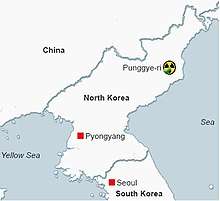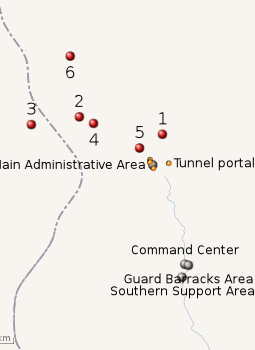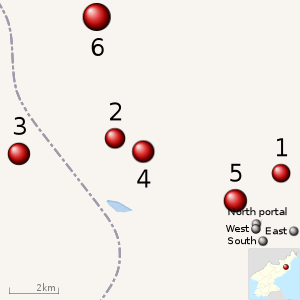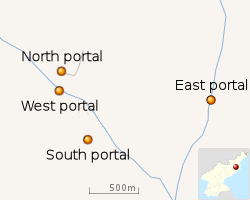Punggye-ri Nuclear Test Site


| Punggye-ri | |
|---|---|
| Country |
|
| Status | Demolished |
| Decommission date | May 25, 2018 |
| Owner(s) |
|
| Operator(s) |
|
| Nuclear power station | |
| Reactor type | Pressurized water reactor |
| Fuel type | Uranium-238 |
 |
| Location of Punggye-ri Nuclear Test Site[1] |
 |
| Location of North Korea's Nuclear tests[2][3]
1: 2006; 2: 2009; 3: 2013; 4: 2016/1; 5: 2016/9; 6: 2017; V |
 |
| Location of Nuclear tunnel portals in Punggye-ri[3] |
 |
|
Punggye-ri Nuclear Test Site (Chosŏn'gŭl: 풍계리 핵 실험장; Hancha: 豊溪里 核 實驗場) was the only known nuclear test site of North Korea. Nuclear tests were conducted at the site in October 2006, May 2009, February 2013, January 2016, September 2016, and September 2017.[4]
Geography
The site has three visible tunnel entrances.[5] Based on satellite imagery, its exact location is 41°16′47.87″N 129°5′10.51″E / 41.2799639°N 129.0862528°E in mountainous terrain in Kilju County, North Hamgyong Province. It is 2 km (1.2 mi) south of Mantapsan, 2 km (1.2 mi) west of Hwasong concentration camp and 12 km (7.5 mi) northwest of the Punggye-ri village. The most proximate settlement to the possible nuclear underground test site is Chik-tong, a small populated place located at 41°16′00″N 129°06′00″E / 41.26667°N 129.10000°E.[6] Sungjibaegam is a settlement located 24 kilometres (15 mi) from the tremor of the 2013 test.[7] Punggye-ri railway station is located at 41°07′51″N 129°09′49″E / 41.130833°N 129.163611°E.[8]
History
In January 2013, Google Maps was updated to include various locations in North Korea.[9] On 8 April 2013, it was reported that South Korea had observed activity at Punggye-ri, suggesting that a fourth nuclear test was being prepared, but the next test did not occur until January 2016.[10][11]
On 6 January 2016, North Korean state media announced a fourth nuclear test had been carried out successfully at the location using a hydrogen bomb.[12] Satellite imagery captured for monitoring website 38 North between January and April 2017 suggested that a sixth nuclear test was being prepared at the site, which was detonated on September 3, 2017.[13]
According to sources, people from the Punggye-ri nuclear test site have been banned from entering Pyongyang since the test due to the possibility of being radioactively contaminated.[14] According to the report of defectors, about 80% of trees died and all of the underground wells dried up in the site after the sixth nuclear test.[15]
On 3 and 23 September 2017, earthquakes which seem to be collapses of tunnels were detected with magnitude of 4.1 and 3.6 respectively.[2] A 17 October 2017 study published by the US-Korea Institute at Johns Hopkins University suggested the most recent test had caused "substantial damage to the existing tunnel network under Mount Mantap".[16][17]
On 30 October 2017, in testimony before the South Korean parliament, the director of South Korea's Meteorological Administration warned that "further tests at Punggye-ri could cause the mountain to collapse and release radioactivity into the environment."[17] Likewise, Chinese scientists warned that if the mountain collapsed, nuclear fallout could spread across "an entire hemisphere."[17]
On 1 November 2017 Japanese TV station TV Asahi reported that according to unconfirmed reports, several underground tunnels collapsed at the test site on 10 October 2017.[18] An initial collapse was said to have killed 100 workers, with another 100 rescuers killed in a second collapse.[19][20]
On 20 April 2018 the North Korean government announced that it would suspend nuclear tests and shut down the Punggye-ri nuclear test site.[21]
On 14 May 2018 it was reported that commercial satellite imagery indicated that dismantling of the facilities at the test site had begun.[22] The leader and Supreme Commander of North Korea Kim Jong-un determined the date for the closing ceremony of Punggye-ri - 23-25 May 2018. The government of North Korea allowed a handful of international journalists (but none from South Korea) to observe the closing ceremony. Notably absent would be experts or inspectors who could study the test site at close quarters.[23]
On 24 May 2018 foreign journalists reported that tunnels in the Punggye-ri nuclear test site had been destroyed by the North Korean government in a move to reduce regional tensions.[24]
References
- ↑ "Punggye-ri Nuclear Test Site: Possible Stand to Observe Explosive Tunnel Closure Identified". 38 NORTH. May 18, 2018.
- 1 2 "Search Results". USGS.
- 1 2 "North Korea's Punggye-ri Nuclear Test Site: Analysis Reveals Its Potential for Additional Testing with Significantly Higher Yields". 38North. March 10, 2017.
- ↑ "KIM'S DISASTER North Korea nuclear base COLLAPSES killing at least 200 people, local reports claim, amid fears of massive radioactive leak".
- ↑ "Punggye-ri Nuclear Test Facility - Facilities - NTI". NTI: Nuclear Threat Initiative. Archived from the original on 29 October 2013.
- ↑ John Pike. "Chik-tong, P'unggye-yok / Punggye-ri (Kilju / Kilchu / Kisshu / Gilju)". Archived from the original on 10 October 2006.
- ↑ "M5.1 – 24km ENE of Sungjibaegam, North Korea". USGS. 12 February 2013. Archived from the original on 13 February 2013. Retrieved 12 February 2013.
- ↑ "P'unggye-yok, North Korea". Archived from the original on 24 September 2015.
- ↑ Cavan Sieczkowski (29 January 2013). "Google Maps North Korea: Prison Camps, Nuclear Complexes Pinpointed In New Images (PHOTOS)". The Huffington Post. Archived from the original on 9 February 2013. Retrieved 20 May 2013.
- ↑ "Activity at North's nuke test site-INSIDE Korea JoongAng Daily". Koreajoongangdaily.joinsmsn.com. 8 April 2013. Archived from the original on 17 April 2013. Retrieved 16 April 2013.
- ↑ 38 North (25 June 2013). "New Tunneling Activity at the North Korean Nuclear Test Site". 38 North. Archived from the original on 1 July 2013. Retrieved 26 June 2013.
- ↑ "North Korea claims Thermonuclear Test". britainscoldwar.uk. 6 January 2016. Archived from the original on 7 January 2016. Retrieved 6 January 2016.
- ↑ Davis, William J. Broad, Kenan; Patel, Jugal K. (2017-04-12). "North Korea May Be Preparing Its 6th Nuclear Test". The New York Times. ISSN 0362-4331. Archived from the original on 14 April 2017. Retrieved 2017-04-13.
- ↑ "Nuke Site Residents Banned from Pyongyang". Chosun Ilbo. 2017-09-20.
- ↑ "North Korea's nuclear test site is 'a wasteland with deformed babies". The Telegraph. 2017-11-07.
- ↑ Byrnes, Jesse (2017-10-31). "Up to 200 killed in North Korean nuclear test site collapse: report". TheHill. Retrieved 2017-10-31.
- 1 2 3 Ryall, Julian (31 October 2017). "Collapse at North Korea nuclear test site 'leaves 200 dead'". The Telegraph.
- ↑ "Fears of Radiation Leak Soar After North Korea Nuclear Site Collapse Kills 200". Retrieved 15 May 2018.
- ↑ "North Korea kills 200 North Koreans testing nukes". New York Post. 2017-10-31. Retrieved 2017-10-31.
- ↑ "A tunnel collapsed at a North Korean nuclear test site, reportedly killing 200 people". Business Insider. Retrieved 2017-10-31.
- ↑ Fifield, Anna (20 April 2018). "North Korea says it will suspend nuclear and missile tests, shut down test site". Washington Post. Retrieved 22 April 2018.
- ↑ "Report: Buildings being dismantled at NK nuke test site". www.msn.com. Retrieved 15 May 2018.
- ↑ Haas, Benjamin (22 May 2018). "North Korea's nuclear test site: is blowing up Punggye-ri just for show?". the Guardian. Retrieved 24 May 2018.
- ↑ "North Korea nuclear test tunnels at Punggye-ri 'destroyed'". BBC News. 24 May 2018. Retrieved 24 May 2018.
Coordinates: 41°16′41″N 129°05′15″E / 41.2780677°N 129.087408°E